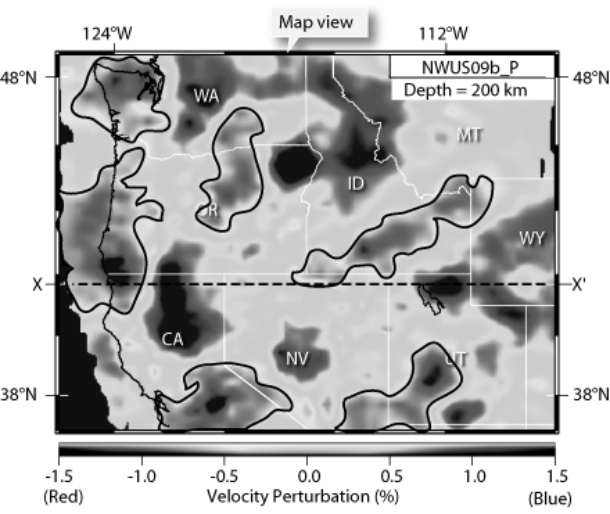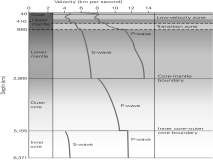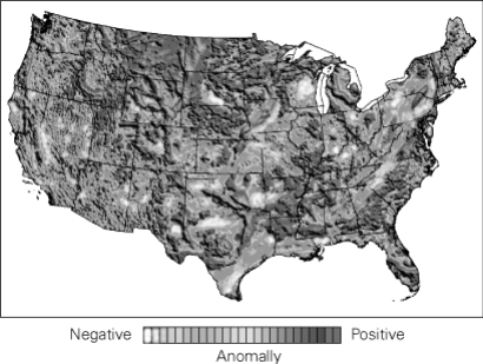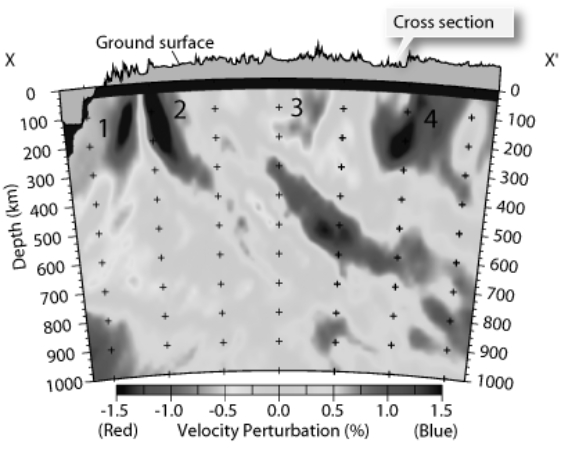A) greater than
B) less than
C) the same as
D) the opposite of
Correct Answer

verified
Correct Answer
verified
Multiple Choice
What causes the velocity of a P-wave to slow down when it enters the outer core?
A) The outer core is a much more dense material than the mantle.
B) The outer core is a much less dense material than the mantle.
C) The outer core is liquid, and thus the wave slows down.
D) The P-wave no longer has to compete with the S-wave for energy.
Correct Answer

verified
D
Correct Answer
verified
Multiple Choice
If an S-wave is traveling through rock when it encounters a magma chamber,the S-wave will ________________.
A) slow down
B) speed up
C) remain at the same speed
D) not travel through the magma
Correct Answer

verified
Correct Answer
verified
Multiple Choice
If a gravity anomaly is negative,what does that imply about the material underground?
A) The material is much more dense rock.
B) The material is much less dense rock.
C) The material is an underground ore.
D) The material is composed of mantle.
Correct Answer

verified
Correct Answer
verified
Multiple Choice
The picture below shows a seismic tomography image of the western United States.What is the relative temperature of the blue regions (darker grey regions not outlined in black) versus the red regions (darker grey regions outlined in black) ? 
A) The blue regions are warmer than the red regions.
B) The red regions are colder than the blue regions.
C) The red regions are warmer than the blue regions.
D) The colors are not indicative of temperature, only velocity.
Correct Answer

verified
Correct Answer
verified
Multiple Choice
Why are magnetic anomalies of continental crust so much more complicated than those of oceanic crust?
A) The continents are much older and thus have had more time for the minerals to become magnetized.
B) The continents contain abundant iron minerals, whereas the oceanic crust does not contain any iron minerals.
C) The continents contain a random orientation of minerals that become magnetized when they interact with the magnetic field.
D) The continents contain a complex distribution of igneous intrusions, lava flows, and iron-rich sediments.
Correct Answer

verified
D
Correct Answer
verified
Multiple Choice
Geophysics is the study of _________.
A) how magma moves within the Earth
B) how Earth's layers change through time
C) the interior of Earth using seismicity, magnetics, and gravity
D) the surface of Earth using seismicity, magnetics, and gravity
Correct Answer

verified
Correct Answer
verified
Multiple Choice
You are studying the seismic data from Mars when you notice that there are no S-waves recorded from 130° through 180° on the opposite side of the planet.What does this information tell you about the interior of Mars?
A) There is a layer of solid material in the interior of Mars.
B) There is a layer of liquid material in the interior of Mars.
C) There is a layer with a higher velocity material than the crust below.
D) There is a layer with a lower velocity material than the crust below.
Correct Answer

verified
Correct Answer
verified
Multiple Choice
S-waves travel ________ than P-waves; however,unlike P-waves,they _______ travel through liquids.
A) slower; can
B) slower; can't
C) faster; can
D) faster; can't
Correct Answer

verified
Correct Answer
verified
Multiple Choice
If a ship towing a magnetometer passes over a piece of crust with a "normal" polarity,what will the magnetic anomaly look like?
A) The magnetic anomaly will be greater than Earth's.
B) The magnetic anomaly will be lower than Earth's.
C) The magnetic anomaly will exactly match Earth's.
D) The magnetic anomaly will be exactly zero.
Correct Answer

verified
Correct Answer
verified
Multiple Choice
The core consists of two layers: the ______ inner core and ______ outer core.
A) iron; nickel
B) nickel; iron
C) solid; liquid
D) liquid; solid
Correct Answer

verified
Correct Answer
verified
Multiple Choice
If a P-wave is traveling through sandstone and then encounters peridotite,the P-wave will ________________.
A) slow down
B) speed up
C) remain at the same speed
D) not travel through the peridotite
Correct Answer

verified
Correct Answer
verified
Multiple Choice
In the following graph,why does the line for S-waves NOT appear in the outer core? 
A) S-waves can't travel through the outer core because it is solid.
B) S-waves can't travel through the outer core because it is liquid.
C) S-waves disappear after being reflected at the core-mantle boundary.
D) S-waves can't travel that far into the Earth due to the high amount of iron.
Correct Answer

verified
Correct Answer
verified
Multiple Choice
A mountain range made of granite would produce a(n) _____________ gravity anomaly.
A) positive
B) negative
C) isostatic
D) magnetized
Correct Answer

verified
Correct Answer
verified
Multiple Choice
Earth's magnetic field is produced in the ___________.
A) crust
B) mantle
C) outer core
D) inner core
Correct Answer

verified
Correct Answer
verified
Multiple Choice
The following picture is that of a gravity map of the United States.What do the dark grey regions mean in terms of the density of the material below? 
A) high-density rock
B) low-density rock
C) rock of high magnetization
D) rock of low magnetization
Correct Answer

verified
A
Correct Answer
verified
Multiple Choice
In the seismic tomography cross section below,where is the subducting Juan de Fuca Plate,considering that the subducting plate is much cooler than the surrounding material? 
A) #4: blue blob at the far right side of the picture that extends straight down into the image
B) #2: blue blob at the left side of the picture that extends down at an angle into the image
C) #1: red blob at the far left side of the picture that extends straight down into the image
D) #3: red blob in the center of the picture that extends straight down into the image
Correct Answer

verified
Correct Answer
verified
Multiple Choice
Earth's gravity is best represented by an equipotential surface that contains bumps and depressions where areas of more or less gravity appear over the Earth,this representation is called the _________.
A) reference geoid
B) gravitational potential
C) isostasy
D) geoid
Correct Answer

verified
Correct Answer
verified
Multiple Choice
If a seismic wave is refracted upward at a boundary,what can be said about the material the wave is traveling through?
A) The wave is moving through two materials of the same velocity.
B) The wave is moving from a faster material into a slower material.
C) The wave is moving from a slower material into a faster material.
D) The wave is traveling through a molten magma chamber.
Correct Answer

verified
Correct Answer
verified
Multiple Choice
Why would the gravity anomaly over a deep-ocean trench be negative?
A) because the bathymetry of the trench dips very far below sea level
B) because dense crust is being pulled into the trench, leaving less dense sediments above
C) because water fills the space above the subducting slab and is much less dense than rock
D) because the buoyant magma created at the subduction zones is less dense than the rock
Correct Answer

verified
Correct Answer
verified
Showing 1 - 20 of 25
Related Exams